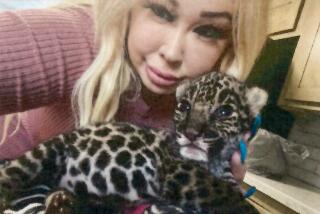Lions and tigers and drugs

- Share via
Reporting from Mexico City — The hippo and crocodiles were statues made of glass and cement. But the lions and tigers were real.
It was one of those odd things drug traffickers do. Like decorating their assault rifles with gold and diamonds.
When Mexican authorities raided a secluded mansion on the outskirts of the capital recently, they did more than capture 15 alleged traffickers. They also discovered a mini-menagerie in a faux-jungle complex of caves, pools and pagodas.
There were cages holding two African lions, two white tigers and two black jaguars. Very Noah-like. Each pair was a male and female. There was also a monkey, sans partner.
It was the third time in recent years that Mexican authorities have made such a find, and similar collections have been seen elsewhere. Notorious Colombian cocaine king Pablo Escobar maintained a 5,500-acre hacienda in his country with a zoo that housed giraffes and elephants, until he was shot to death by Colombian security forces in 1993.
Drug-trafficking bosses, some of them at least, like to surround themselves with exotic animals. They do it because they can, and because they like to show off. They do it, experts say, as a sign of their virility and bravado. It’s a trophy, a status symbol.
“Any kind of animal that is very rare, expensive or exclusive -- white tigers, very expensive pedigree dogs, tropical birds” -- is what these gangsters favor, said Maria Elena Sanchez, head of the Teyeliz animal advocacy group. “It is their declaration of power.”
They have the money to purchase the creatures, legitimately or on the black market, and to maintain them. The tons of red meat that lions need to consume, for example, cost big bucks.
They have access to the illicit smuggling rings that can procure animals that are often on endangered-species lists. Animal traffickers and drug gangsters share berths in the same murky, violent underworld.
But when the criminals are captured, the fate of these creatures can be bleak.
Here in Mexico City, federal authorities this month raided the “narco-mansion,” as it is being called, near an area known as the Desert of the Lions. Police arrived in the middle of what was described as quite a party. Bottles of liquor and pieces of bathing suits remained in the aftermath.
Authorities said they arrested 15 people -- 11 Colombians, two Mexicans, a Uruguayan and a U.S. citizen. The Colombians were allegedly connected to a major drug ring in their country and included four women. One of the Mexicans was the disc jockey son of a famous actress and her singer husband, a hint at the availability of some of Mexico’s show business folk to the highest payer.
But it was the animals that typified the excesses of the alleged traffickers.
“A lot of people like to possess exotic animals,” Adriana Rivero, a senior official with the government’s environmental protection agency, said in an interview. “But it costs a lot of money if you are going to do it legally and in a way that maintains the dignity of the animal’s captivity.”
In addition to paying for the food, she said, the owner ideally should have a caretaker on staff who is specialized in handling the species, plus a regular veterinarian. And animals of such size need space, light, shade and so forth.
Though it is not clear whether the occupants of the mansion had such a support staff, the surroundings in which the lions, tigers and jaguars were found were more than adequate, Rivero said. They were kept on the elaborate compound until eventually being transported to a zoo in Guadalajara.
And they were found to be in good health: Their coats were shiny and they did not seem to fear humans, she said.
If anything, the giant cats may have been overfed. They were a bit fat.
Wilkinson is a Times staff writer.
More to Read
Sign up for Essential California
The most important California stories and recommendations in your inbox every morning.
You may occasionally receive promotional content from the Los Angeles Times.











